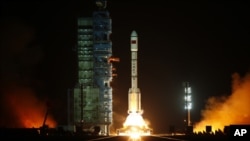China has launched an unmanned spacecraft, in what is described as Beijing's first step toward building its own space station.
The 8.5 ton module - known as Tiangong-1, or "Heavenly Palace" - lifted off from Jiuquan Satellite Launch Center, a site in China's northwestern Gobi Desert, late Thursday night local time. The craft was propelled by a Long March 2F rocket.
Detailed reports about the launch were splashed across Chinese newspapers and the development was hailed by state-run broadcasters. State television beamed a live broadcast of the launch into homes across China.
The importance of the event was underscored by the presence of China's top leaders - including President Hu Jintao and Vice President Xi Jinping - at the Beijing command and control center. Chinese Premier Wen Jiabao was at the Jiuquan Center to witness the launch in person.
Another unmanned spacecraft to be launched November 1 will meet up with the module for China's first space-docking procedure.
China plans several more rendezvous-and-docking procedures before the end of next year - at least one of which will be manned. The program calls for construction of a space laboratory by 2016 and completion of a 60-ton space station around 2020.
Foreign Ministry spokesman Hong Lei said that China's activities in space are peaceful. Hong says China is ready to work with other countries on things like manned space missions that he says will contribute to the advancement of world space technologies.
China conducted its first manned space flight in 2003, more than four decades after pioneering flights by the United States and Soviet Union. The latest efforts come at a time when the retirement of the U.S. space shuttle fleet has left the future of the American space program in question.
Australian-based space analyst Morris Jones tells VOA the module launched Thursday will allow China to test some of the technologies it will need for the space station.
The China Daily newspaper on Thursday quoted a program spokeswoman as saying the same technology can be used for moon landings and deep-space exploration, though there is presently no timetable for a moon landing. Many Western analysts believe a moon landing is China's ultimate goal.
Thursday's launch had been scheduled for August 18, but was postponed after a Long March 2-C rocket failed in the attempted launch of a satellite earlier this month.
Some information for this report was provided by AP and AFP.











